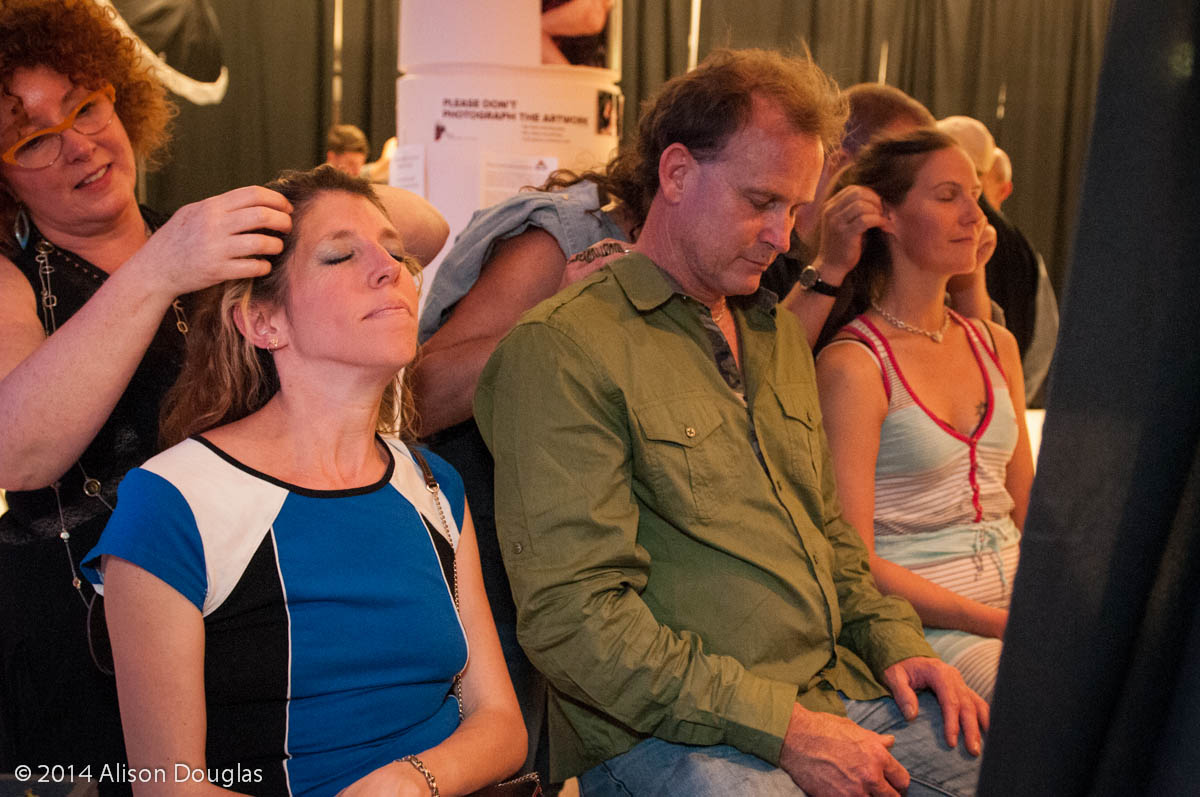Omphaloskepsis Blog
Ironic Participation at the Seattle Erotic Art Festival
Jul 19, 2014
It's all fun and games at the Seattle Erotic Art Festival
I produced and performed a piece of Social Art. Some say Social Sculpture. Others call it Ironic Participation. Social art is often political in nature, but not mine. My Social Art really has to do with Ironic Participation, audience apropriation. They're fun, quirky, interactive, temporal works that niggle at the audience, teases them in a loving way in order to get at a deeper concept.

Ironic Participation
In Ironic Participation, the artist eploits the role of the viewer as the art object. The primary role of social art is not one of beauty, but of intervention through discomfort. The audience has an interdependent relationship with the work.
Art critic Clair Bishop said that social art “Assumes the creative energy of participatory practices. It rehumanizes or at least de-alienates a society rendered numb and fragmented by the instrumentality of capitalism.”

My work deals with permission, access and boundaries and seeks to bring to light the crisis in relationship between art and society by appropriating my audience. It’s born out of an authentic desire to engage my audience. It goes beyond the pleasure principle to cross a threshold that can produce a change by incarnating a blind spot—making the invisible visible.
Receivers are integrated into systems of participation whether they want to be or not. They come to grips with their own relationship to the work. I play with triggers in order to engage people—humor, pranks and hoaxes. It can be politically incorrect to make an experiment of art in order to make comfortability uncomfortable. Humor helps make the situation more accessible. This is my big opportunity to toy with my audience.

It’s natural for me to use intervention because I am a part of this life. I am compelled by this work because art can bring about development in our consciousness. It’s more important for art to generate experiential knowledge. My participants are invited to complete the narrative. Viewers are implicated into the work in order to demonstrate it. When I make myself vulnerable, I make others vulnerable as well. This can come with a strong discomfort reaction in the viewer.
Through discomfort, I aim to challenge their awareness in the particular, and perhaps in the broader world around them. The purpose of antagonism is to expose the limits of everyday objects and to expose the key social structure of people and things that appear disconnected.

Poor Impulse Control
“Stop! Don’t touch me there! This is my no-no square.” is a gleeful chant that finger-wagging, middle school girls are singing these days. Poor Impulse Control is a performance-based, audience participation work that examines the “no-no square” of (un)invited human interaction with strangers who touch the hair on another’s head.
In Poor Impulse Control people with textured hair are the subjects and audience members are invited to surrender their impulse control and freely touch, stroke, squeeze and pull the hair of the subjects. Poor Impulse Control combines a setting that includes several people on stools and pedestals, curtains and drapes and the arbiter/artist. The clothed subjects, who have the kind of hair that’s nearly impossible to resist touching, willingly submit to unseen strangers touching the hair on their head.
In Poor Impulse Control, visitors are invited into an unembellished space in which subjects sit on high stools, with their backs to the visitors who are free to put their hands into the subjects’ hair. By granting access to other people’s bodies, Poor Impulse Control is a sensual work of social art that asks questions such as: What are the boundaries? Who has the implied power and who is powerless? And, What are acceptable ways of connecting and sharing intimacy with strangers?

The eye is the visible part of the brain, and it covets what it sees. All my life I’ve been approached by strangers who, unable to restrain or control their urge to touch my hair – run their hands through my hair, pull my curls, and insert their fingers inside my ringlets. I’ve never been threatened by these actions. For me, my hair has always been something that’s visibly special about me, something that elicits both positive attention and joy.
The collapse of the emotional and physical boundaries inherent to the human experience is a recurrent theme in my work. From large-scale paintings that immediately disorient viewers, dissolve all sense of place or position and result in an emotional tailspin, to concept driven work that invites strangers to confront their childhood fantasies and fears. Like John Cage, Joseph Beuys, and Felix Gonzales-Torres, my work directly engages participants communally, even as it remains distinctly personal to each audience member. Although initiated by a single creator, audience participation is fundamental to making my work come to life. And while Poor Impulse Control specifically challenges participants to cross real or imagined boundaries, the work itself goes beyond, to actively breach the divide between artist and audience.
Other posts you may also enjoy:
Red Rice and Beings: http://katevrijmoet.com/blog/red-rice-and-beings/
Lollipop Peep Show: http://katevrijmoet.com/blog/lollipop-peep-show/
Mother May I...? in Brooklyn http://katevrijmoet.com/blog/mother-may-i...-in-brooklyn/
Don't Do That! http://katevrijmoet.com/blog/dont-do-that/
 MENU
MENU